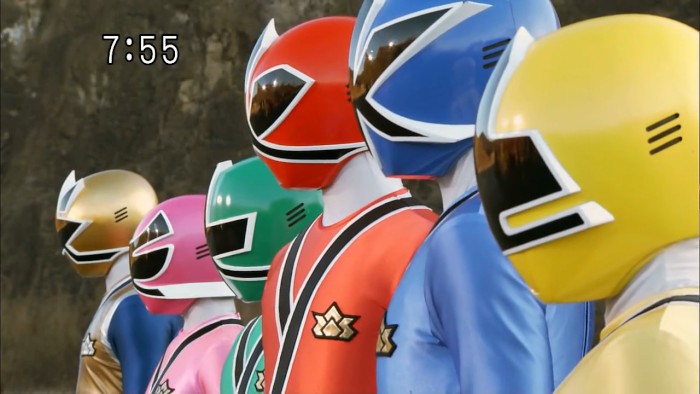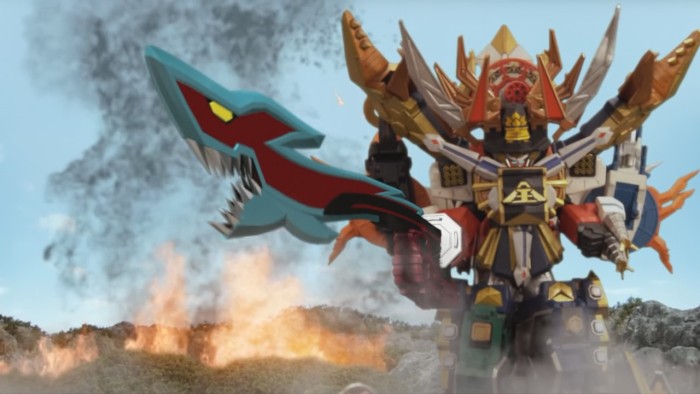 |
|
| You are here: Index > Surveys of Secondary Worlds > Samurai Sentai Shinkenger (2009) | |
Reviewing Samurai Sentai Shinkenger (2009)[written on 10-20-2025]My tokusatsu journey has finally come full circle. Power Rangers Samurai was my first exposure to the genre many years back, and from there I saw some Power Rangers in Space and I think Power Rangers RPM as well. In recent months I even watched a couple episodes of Power Rangers Dino Thunder, and it was pretty enjoyable even to my current palette. There's a reason these localizations have taken off, but generally they aren't held in as high regard as their Sentai counterparts. Samurai Sentai Shinkenger is a good example of this, because I am blown away by how good it is. This might actually be my favorite tokusatsu season to date: great cast, fun action, good mix of humor and serious moments, and a good story about duty and friendship. I haven't felt that moved by a show in a while, and I am pleasantly surprised that the source material for my toku origins has resonated so deeply. 
Personal Scorethis criteria uses the DecentFilms rating formula.Letter-Grade Recommendability: A+ The setting for Shinkenger is very japanese in nature. In another realm lies the Sanzu river, populated by demonic monsters called the Gedoushu. These monsters often enter our world through cracks in order to feed on human suffering, which in turn fills the Sanzu river and allows the Gedou even more access to our world. They have not gone unopposed, however; the Shinkengers have existed for generations, headed by the Shiba clan, with the goal of defeating the Gedoushu wherever they may appear throughout Japan. We follow Shiba Takeru and his vassals as they form the newest generation of Samurai Sentai, training in the mystical power of Mojikara and taking on Chimatsuri Doukoku and his monstrous forces. The general structure of the story is fairly episodic but follows a steady increase in power; over the course of the run the Shinkengers learn new powers for their weapons, Origami that serve as their mecha, and even new members. Something that immediately appeals to me about Shinkenger is the aesthetic. One of the major qualities of japanese media is the culture that is ingrained into it, and this season wears its nation's heritage proudly. The Sentai outfits are brilliantly simple and imitate samurai garb, and that extends into their fighting style with traditional samurai slashes. Organizing the team into a feudal samurai clan works really well in establishing the world, and it's entertaining to see how both old and new parts of japanese culture make their way into the gadgets and powers. A good example of this is Shinken Gold, a sushi seller who learns to tap into mojikara through his electronic flip-phone. It plays nicely into a major theme of the season, that being carrying tradition into the modern day.  This is highlighted through the struggles of the characters, and I think this is the best cast in a tokusatsu season I've had the pleasure of watching. Every single Shinkenger has a strong personality and struggle that keeps you in their corner constantly. My personal favorites include Ikenami Ryunosuke, an energetic theater kid who struggles with giving up kabuki for his duty as Shinken Blue, and Umemori Genta, the goofy sushi seller who feels inadequate as the first Shinken Gold and a lack of official samurai upbringing. Tani Chiaki is a fun punk who helps challenge Shiba Takeru's firm but considerate leadership, and Hanaori Kotoha is a young and naive girl who works through her low self-esteem. If I had to name a weak link it would probably be Shiraishi Mako, but even then she has her own struggles as her family's desires and her desire to be a mother clash with her immediate responsibility to be a Shinkenger. This is a team that is forged throughout its runtime and it pays dividends of satisfaction when they stand together as a family and a unit. I have mixed feelings about the villains, though. The main pull of the show is definitely its Sentai team, but while there are some good characters amongst the Gedoushu I did feel like the main antagonist was pretty flat. Doukoku spends his whole screentime in a general state of drinking and seething about the Shinkengers, and I wasn't convinced of his menace for quite a while. This is especially true when his advisors, namely the general Akumaro and the seer Shitari are a lot more sinister in their planning. Doukoku is a big deal in name only until the end, where he serves as a very predictable final boss, and I did find that disappointing. What does keep the villain corner fresh is the fallen humans who became Gedou, namely Usukawa Dayu and Fuwa Juzo, who serve as interesting rogues throughout the series and pop up quite frequently to challenge the Shinkengers. There is an especially strong contrast between Fuwa Juzo and Shiba Takeru, and their rivalry is very well-felt as it spans almost the whole runtime of the show. While they don't play too strong of a role in the overall plot they do help reinforce the theme; these are humans who through strong desire have fallen into darkness, and it is a good reminder of placing one's actions over one's vice. Now I've seen a good deal of tokusatsu action now, and after watching Shinkenger I feel like it had one of the better production values. Comparing it to Liveman shows many areas of improvement, like more ambitious stunts and more ambitious effects, though in fairness that is more due to how complex the power system is in general compared to something from the Showa era. This is no more apparent than the mecha battles, because the difference between Liveman and Shinkenger in this regard is night and day; Live Robo felt like a mandated aftermath to every battle, but in Shinkenger the battles are far more varied depending on what they have to face. Samurai Gattai has a very complex design, one that you could argue gets a little convoluted with how much stuff they cram onto it over time, but its wide range of combinations and add-ons make it not only versatile in utility but also just aesthetically interesting to look at. Even when Shinken-Oh is up against enlarged grunts it still attempts different tactics to defeat them and that makes it feel like a genuine continuation of the action down below, or in some cases alongside the ground battles. I really appreciated this after Liveman and I'm glad to see the action here have so much range.  I was very pleased with Shinkenger. It took a very likeable cast and gave them all sorts of fun adventures while also engaging me with its serious moments and themes. The finale for this season gave me that lightness of the heart that the best stories give, and I don't think I could ask for better satisfaction than that. This is certainly the bar that I will hold future tokusatsu at as I continue to explore what other good stories are hiding within this genre. |
|
Exodite.org | 2023-2025





|
|